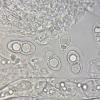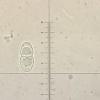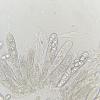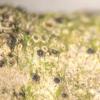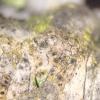
27-08-2025 12:02
Pavol PaloHello dear friendsI would like to ask for sharing

25-08-2025 17:37
 François Freléchoux
François Freléchoux
Bonjour,Nous avons trouvé samedi dernier à l'ét

20-08-2025 19:04
Ethan CrensonHello, This asco was found on the same wood as my

22-08-2025 08:41
Masanori KutsunaHello.Can anyone help me to get this article?Liu H

21-08-2025 02:18
Stefan JakobssonOn a necrotic section of a living Tilia cordata I
 Hi
HiFound on fallen ulmus twigs. Dont know if its lichenicolous or if it grows on ulmus. But it seams that it will appear were lecanora is present. Ebr />Spores 26-30x 12-14um with epispor 4-5 um wide old Spores verrucose light brown.
Asci 125-145x 15-17 um
Asci lugol negative K+I negative
Asci 8 spored
Parafyses septate
Involucrellum react K+green
Anyone have seen anything like it or knows genus?
i have tryed some keys with no match.
All the best,
Robin
Hallo Robin,
to me (as a lichenologist) the ascomata look like to belong to a saprophytic fungus
the lichen seems to be (almost) dead overgrown in some parts by colonies of epiphytic green (non-symbiotic) algae
what suggests the branch (and the lichen) is dead for relatively long period
lichenicoles are also usually much smaller
I must say that I am not the expert at all but tried to pass through some literature and older discussion on this forum
one of the candidates could be Dothidotthia ramulicola ?
discussed on the forum 6 years ago: see: "
http://www.ascofrance.com/forum/26773/didymosphaeria
the discussed specimen is at least seemingly slightly similar to yours, which could be immature? as noted in the discussion by Walter Jaklitsch for this taxon?
but maybe I am completely wrong, better to ask an expert on bitunicate pyrenomycetes
according to the description in the monograph by Barr (1989) in Mycotaxon this species should form gregarious ascomata on a stroma
perhaps the mentioned taxon is a dustbin name ?
all the best
Zdenek

Thank you for the replay and your effort to find a candidtae.
As you say we could exclude lichenicoles, I will ask Walter to se if it is the species you named but as it seams it is only pertecia one by one and no gregarious ascomata on a stroma but i will cut and look closer on material when i home.
All the best,
Robin





